| Columns Retired Columns & Blogs |
The DIY Chronicles, Part Five
Editor's Note: This is Part Five of a six-part series from reader Hervé Delétraz of Switzerland, who is chronicling the development of his DIY (do-it-yourself) audio amplifier. Part One of the series is here, Part Two is here, Part Three is here, and Part Four is here.
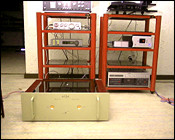 As you probably noticed in my last article, the finished amp case for this home-brew project is pretty huge and heavy; without components, it weighs about 25kg. I made a big case only for the prototype, however, as this would allow easy tuning and maintenance at any time. Because the first listening sessions have impressed everyone who has heard my baby, I plan to produce it in a small series. Of course, the case dimensions will be reduced sufficiently to fit in a standard hi-fi rack, and to match most audiophile wallets. But that's another story. Now that the amp—the "darTZeel NHB-108 model zero"—is designed and built, the most important test is how it sounds.
As you probably noticed in my last article, the finished amp case for this home-brew project is pretty huge and heavy; without components, it weighs about 25kg. I made a big case only for the prototype, however, as this would allow easy tuning and maintenance at any time. Because the first listening sessions have impressed everyone who has heard my baby, I plan to produce it in a small series. Of course, the case dimensions will be reduced sufficiently to fit in a standard hi-fi rack, and to match most audiophile wallets. But that's another story. Now that the amp—the "darTZeel NHB-108 model zero"—is designed and built, the most important test is how it sounds.
Listening Tests
The first listening tests—I hope others will follow—were made both at my home and at a dealer's shop. The panel of listeners included around 50% audiophiles, 30% sound engineers, and 20% music-loving non-audiophiles. Caution: I'm not saying that audiophiles don't love music! (I'm an audiophile myself!) It's just that non-audiophile pals/gals just listen to the piece itself, not to the electrons traveling from source to speakers.
At home, no cross-brand comparisons were made. We just listened to the music. At the shop, comparisons were made with other power amps. Various jazz, rock/pop, and classical records and CDs were auditioned at both locations.
Listening Sessions at Home
The audio system at home was composed of:
Digital: Teac VRDS transport, Sonic Frontiers SFD-2 Mk.II
Analog: Goldmund Studietto turntable w/Goldmund T5 tangential arm, Audio-Technica OC-9 cartridge
Preamplifier: Nagra PL-P
Loudspeakers: Rehdéko RK175A
Tuner: Quad FM33
Interconnects: Kimber KCAG, unbalanced only
Loudspeaker cables: DNM single-core, tri-wired
 Stéphane Henriot, sound engineer: "On the vinyl of Madonna's 'My Substitute for Love,' I was glued to the chair. Madonna's voice took all the room space, both in width and height. All the intimate sibilants were perfectly rendered, without any aggressiveness. The subjective dynamics were limitless, as free as musical instruments or live voices can be. With the Michel Jonasz tune 'Le temps passé,' the bass was deeper than I've ever heard, without being slow or fuzzy. I could perfectly hear and feel every vibration. The voice of Jonasz was extremely clear and pure (no intermodulation), even during the loud passage of the bass section. Hervé, I want one!"
Stéphane Henriot, sound engineer: "On the vinyl of Madonna's 'My Substitute for Love,' I was glued to the chair. Madonna's voice took all the room space, both in width and height. All the intimate sibilants were perfectly rendered, without any aggressiveness. The subjective dynamics were limitless, as free as musical instruments or live voices can be. With the Michel Jonasz tune 'Le temps passé,' the bass was deeper than I've ever heard, without being slow or fuzzy. I could perfectly hear and feel every vibration. The voice of Jonasz was extremely clear and pure (no intermodulation), even during the loud passage of the bass section. Hervé, I want one!"
Bruno Fonnesu, sound engineer: "I didn't think that transients could be produced at such speed on an audio system. The NHB-108 impressed me so much that the active Genelecs we have in our studio suddenly seemed obsolete, slow and foggy."
 Claude Kember, sound engineer and drummer: "I was skeptical when you said that snare drums would shut my eyes. But I have to admit that they did! The transients were so fast that I believed the speakers' membranes would be launched through the listening room. The kick was at least as impressive as when I play myself for real."
Claude Kember, sound engineer and drummer: "I was skeptical when you said that snare drums would shut my eyes. But I have to admit that they did! The transients were so fast that I believed the speakers' membranes would be launched through the listening room. The kick was at least as impressive as when I play myself for real."
Renaud Lewandowski, sound engineer: "What a terrific look! I want one! (before even listening to it) As I'm not very accustomed to listening to hi-fi gear, it was hard for me to tell which element was responsible for this—for me—never previously heard sound. Was it the preamp, the speakers, or the NHB-108 itself? At least I can swear to you that I will remember that day!"
 Serge Spiga, sound engineer/musician: "As soon as the NHB-108 played its first notes, I smiled. The music surrounded me and I was almost immediately immersed in the event. Silky violins, velvet voices, hammer-like bass, and shiny cymbals. Need a drawing?"
Serge Spiga, sound engineer/musician: "As soon as the NHB-108 played its first notes, I smiled. The music surrounded me and I was almost immediately immersed in the event. Silky violins, velvet voices, hammer-like bass, and shiny cymbals. Need a drawing?"
Serge Roch, music enthusiast: "Very transparent, virtually free of any stress, dynamically limitless, very precise, very true."
My own opinion: "The fastest transients I've ever experienced, with extremely wide-spectrum extension."
Listening Sessions at the Dealer's Shop
The dealer's audio system was made up of:
Digital: Sonic Frontiers Transport 3/DAC 3
Analog: None
Preamplifier: Sonic Frontiers Line 2
Loudspeakers: Spendor SP9/1
Power Amplifiers: Sonic Frontiers Power 3, Theta Dreadnought (2 channels), NHB-108.
Jean Mateu, audiophile: "The NHB-108 is more transparent, quicker, deeper, and more natural than the Power 3. I tend, however, to prefer the warmer, more euphonic sound of the Power 3."
Jean-François Bosset, audiophile: "I've never heard the Spendors sound so good! The NHB-108 perfectly drove them, and the bass extension was the deepest I've ever experienced with these speakers. The dynamic was stunning, and the violins were milky. When connected to the Power 3, all the magic was gone. The vertical presentation flattened, the dynamic disappeared, the fun was no longer present. Back to the NHB-108, I felt as if a curtain was removed from the speakers. I also found that the 100Wpc of the NHB-108 sounded much more loud than the Power 3's 220Wpc."
Maria Rosa Delétraz, my beloved wife: "I'm not an expert, but I found that sibilants were much more aggressive on the Power 3 than with the NHB-108. The bass were also more palpable on the latter."
Philippe Rod, the dealer: "As soon as the NHB-108 was powered on, I was blown away. How could a DIY amp sound so great? I checked if the Power 3s were correctly connected, and they were. The NHB-108 was more transparent and quick than the Power 3, with a minor lack in vertical spaciousness compared to the Power 3. After 30 minutes of comparisons, I shut the Power 3 off. The NHB-108 was simply more communicative. A couple of days later I compared the NHB-108 to a Theta Dreadnought 2-channel power amp. Two solid-state power amps, so the stunning bass performance of the NHB-108 could suffer vs. the Theta. Surprise, surprise! The NHB-108 was more free, more transparent, more dynamic, tighter, and deeper than the Theta. Could you believe it? I did."
Measurements
Input impedance: 58k ohms (voluntarily decreased) from 5Hz to 600kHz (!)
Output impedance: 0.28 ohms at 20Hz, 0.25 ohms at 20kHz
Power before clipping, at 2% THD, both channels simultaneously: 135Wpc into 8 ohms, 210Wpc into 4 ohms
Rise and fall times: 500 nanoseconds
Slew rate: Better than 80V/µs, peak
Note: As the design is simple, it's very easy to tailor almost every parameter to the listener's tastes, without adding any exotic components. These measurements reflect the purest (to my ears) sound available, as auditioned during the listening sessions. Input impedance, bandwidth, phase, low cut and high cut, rise/fall times, and gain can all be adjusted for those who like a more "euphonic" sound; i.e., maybe more hi-fi than really lifelike.
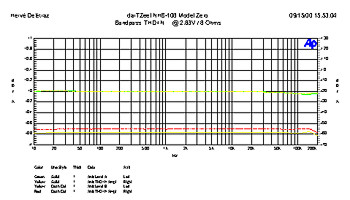
Fig.1: The bandwidth is very wide, as the attenuation at 200kHz is only –0.04dB. The THD+noise is fair, considering the total absence of output-stage feedback, and does not vary across the whole audioband. The worst figure is for the right channel, with –55dB corresponding to 0.18%.
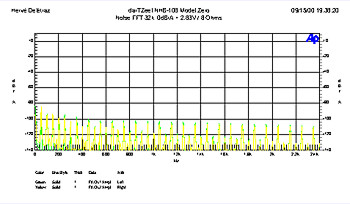
Fig.2: This is the noise figure referenced to 2.83V into 8 ohms, clearly showing that the power supply can be much improved. All the peaks are 50Hz harmonics. However, the peak noise is generally below –100dB referenced to 1W into 8 ohms.
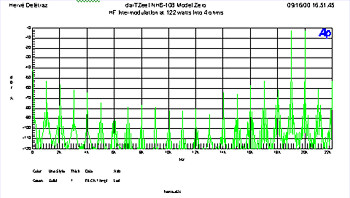
Fig.3: This is the intermodulation distortion with 19+20kHz at 122W into 4 ohms (the worst case). No miracle here; all the harmonic products are clearly visible. However, again, the higher values are also around –55dB, corresponding to 0.18%.
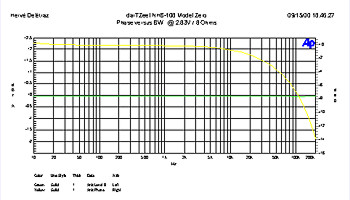
Fig.4: This is the phase shift, input to output (yellow trace). The group-delay propagation is very good, with only 1.6° phase shift from 20Hz to 20kHz.
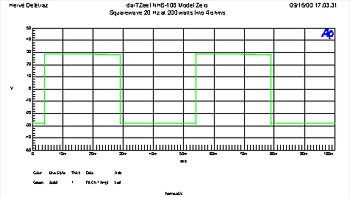
Fig.5: This is the 20Hz squarewave response. It shows perfectly flat plateaus, indicating very deep bass extension. It's not a traditional measure, as we usually show the 10kHz figure, which was textbook-perfect but with a 2% peak overshoot. (The skilled guys would appreciate this.)
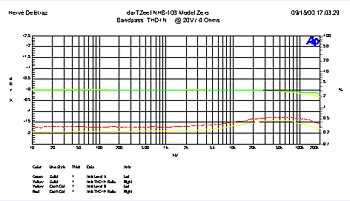
Fig.6: This the power bandwidth and THD+noise at 100W/4 ohms. The response is still very flat, –0.25dB at 200kHz. The THD is slightly higher here, with around 0.3–0.4% at 20kHz.
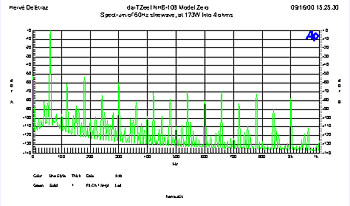
Fig.7: The spectrum of a 60Hz sinewave, 173W into 4 ohms, indicates slightly higher odd harmonics than even ones, while the highest-level product is at 180Hz (the third harmonic) at around –55dB, or 0.18%.
Next week, Hervé Delétraz wraps up, and thanks those who helped him realize his amplifier project. Readers can contact Hervé Delétraz via e-mail at deletraz@bluewin.ch.
- Log in or register to post comments




































